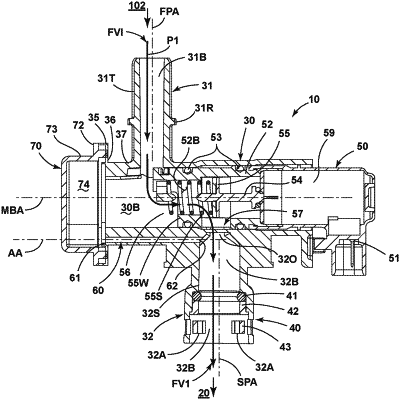| CPC B60K 15/03519 (2013.01) [F02D 41/004 (2013.01)] | 16 Claims |

|
1. A fuel tank isolation valve in an evaporative emissions system having a fuel tank and a canister, the fuel tank isolation valve comprising:
a main valve body including an outer rim, a first port and a second port, the first port in fluid communication with a fuel tank and the second port in fluid communication with a fuel vapor canister, the main valve body defining a main bore through which vented fuel vapors can move from the first port to the second port, the main bore including a main bore axis;
an actuator joined with the main valve body and disposed in the main bore, the actuator operable in an open mode in which fuel vapors from the first port can move to the second port through the main bore along a first path, and a closed mode in which fuel vapors are inhibited from moving from the first port to the second port through the main bore along the first path due to the actuator occluding the first path;
an airflow bypass orifice defined by the main valve body and including a first opening defined by the outer rim and a second opening that opens to the second port, the airflow bypass orifice parallel to the main bore and in fluid communication with the first port and with the second port; and
a cover defining a cover cavity and including a base and a wall, the base joined with the outer rim of the main valve body, the wall extending away from the outer rim,
wherein the airflow bypass orifice allows fuel vapors to be vented from the first port, through the main bore and the cover cavity to enter the first opening in the outer rim and exit the second opening into the second port along a second path, while the actuator is in the closed mode and the fuel vapors are inhibited from moving from the first port to the second port through the main bore along the first path due to the actuator occluding the first path,
whereby flow of fuel vapors along the second path through the airflow bypass orifice equalizes pressure within the fuel tank and canister during a purging operation on the canister in which a vacuum is drawn by an engine through the canister.
|